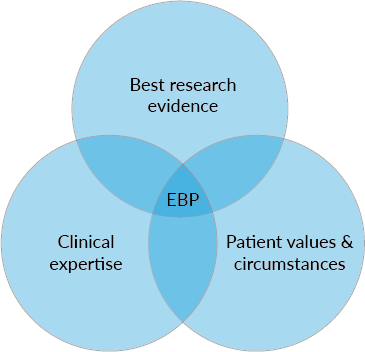Evidence-Based Practice
Evidence-Based Practice (EBP) utilizes scientific evidence to guide clinical decision-making. EBP involves developing a focused clinical question, then acquiring and evaluating the best available evidence.
What is Evidence-Based Practice?

Evidence-based practice is defined as the “integration of best research evidence with clinical expertise and patient values.” These components allow clinicians to make decisions supported by research and provide individualized patient-centered care.
Sackett DL. Evidence-Based Medicine : How to Practice and Teach Ebm. 2nd ed. Edinburgh: Churchill Livingstone; 2000.
The EBP Process
The process begins with the patient and proceeds with the following steps:
- Ask a clinical question
- Identify the patient need and use a tool such as PICO to develop a focused clinical question.
- Acquire the best available evidence
- Use the evidence pyramid to identify the best study types for your question. Search databases to find the best relevant evidence.
- Appraise the evidence
- Use the quality of evidence checklist to critically evaluate the research.
We can help with steps 1, 2 & 3!
- Apply the evidence in practice
- Combine the evidence with your clinical expertise and the patient’s values and preferences.
- Assess the outcome
- Monitor and evaluate to determine the effectiveness of the intervention
Questions & Help
If you have questions on this, or another topic, contact a librarian for help!
